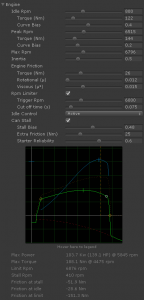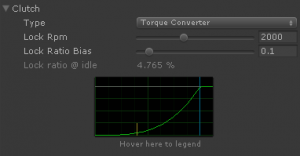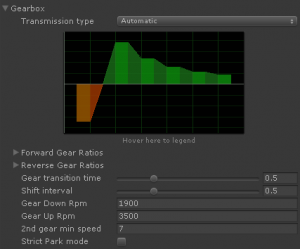Introducing the key components of a vehicle’s transmission that are simulated in my upcoming vehicle physics system, Vehicle Physics Pro for Unity 3D.
Engine
 The engine curve was briefly introduced in a previous post. Now I’ll describe the actual features and working modes of the Engine component.
The engine curve was briefly introduced in a previous post. Now I’ll describe the actual features and working modes of the Engine component.
The basis is simple: when throttle is applied the engine produces torque according to the actual rpms and the torque curve. When no throttle is applied, the engine produces brake torque only.
The torque curve can be easily configured out of real data by directly configuring specific torque and rpm points in the inspector. Then adjusting the friction values makes the curve to match the shape and specs of the real one. The power curve is calculated out of the torque curve.
A tricky point not always noticed is keeping the engine powered while idle (that is, compensating the friction at the idle rpms), then combining idle with throttle when applied. The engine component can simulate this in two ways:
- Passive: The engine always produces a minimum power that counteracts the engine friction at idle rpm. This minimum power is generated even without throttle applied, i.e. in engine-brake mode. This mode is typical in the carburetor-based cars. They can be easily stalled if releasing the clutch with not enough throttle applied.
- Active: Vehicle’s electronics automatically apply the necessary power for keeping the idle rpm. This power is applied when the rpms are below the idle value. In engine-brake mode no power is being applied at all. For instance, the high-torque diesel engines combined with the electronics keeping the idle rpm makes these vehicles harder to stall. They can even climb steep roads with the engine at idle, without throttle being applied.
Rev limiter
Despite the physical rpm limits of the engine described by its power curve, the engine can also be set up to cut the power above certain rpm to protect the mechanical parts.
Stall and startup
The engine can be configured to stall under realistic conditions, or not to stall at all. The power and friction curves are properly defined at all stages and can be configured for making the vehicle harder or easier to stall.
Ignition key and startup engine are both simulated. A parameter “starter reliability” defines how likely the engine will be able to start or not. This parameter may be used for simulating parameters like external temperature, battery level, etc.
The engine provides extra friction when stalled. If the car is moving while stalled the engine can be ignited again by releasing the clutch with a proper gear engaged, just like in reality.
Clutch
 This component has been surprisingly simple to implement in my vehicle simulation model. Several different working modes are provided:
This component has been surprisingly simple to implement in my vehicle simulation model. Several different working modes are provided:
- Lock ratio: a fictitious but simple to use clutch, where 0.0 is disengaged (transmission open) and 1.0 is engaged (locked). Any value in between provides proportional lock ratio. The actual amount of torque transfered depends on both lock ratio and engine torque.
- Clutch pack: this is the realistic clutch. It provides friction torque progressively up to a maximum amount. The clutch pack transfers a constant amount of torque for a given clutch pedal position, regardless of the actual torque provided for the engine. As bonus feature, clutch wear can be easily accounted by lowering the maximum torque transfer value, so the component could even simulate clutch slipping accurately.
- Torque converter: a fluid coupling that provides smooth and progressive lock based on the rotational speed at both ends. Typically used in automatic transmissions. However it can greatly improve the gameplay when used with manual transmissions, as the user doesn’t have to worry about clutch.
Gearbox
The gearbox actually defines the type of the transmission for the vehicle. Most vehicle simulations implement “automatic transmissions” as “manual gearbox with auto-shift”. Vehicle Physics Pro simulates a true automatic transmission with the realistic effects of smooth gear shifting. Even changing from forward to reverse is performed in a perfectly smooth transition.
Supported transmission types:
- Manual transmission: gearbox engages each gear by demand.
- Manual transmission with auto-shift: a manual transmission where appropriate gears are automatically engaged according to the configured rpm values.
- Automatic transmission: a complex mechanism that engages the gears by applying clutches on a planetary gear system. Provides smooth continuous transitions when shifting gears.
- Semi-automatic transmission: An automatic transmission in Manual mode where gears are shifted manually in sequence. Most cars with automatic transmission also provide a semi-automatic mode.
More information
The documentation site is live: http://vehiclephysics.com. I’m writing it as I develop the package. The development roadmap is available at the front page.
The twitter @VehiclePhysics has frequently updated information and screenshots on the development progress.
You can find a lot of interesting under-the-hood information on Vehicle Physics Pro here:
http://vehiclephysics.com/advanced/misc-topics-explained
Interested on testing Vehicle Physics Pro even at its Alpha state? I’m opening Early Access with the Professional License add-on ($200). Check out the licensing section for more information.

Edy great work !!! Keep up the good job !!
It’s possible to have high and Low range gears ?
Can you also add this feature :
https://www.youtube.com/watch?v=0MOvirz0UKU
thanks !!!!
Nothing prevents you to use two gearboxes connected together 😉 A component “VPGearSet” is also provided which can be used in front of a GearBox for setting those high and low range gears.
The deformable terrain is not on the road map at this time. I’m currently focusing on vehicle physics only.
thanks 😉
So… I am getting a serious problem. I have no idea how to calculate engine RPM and wheel angular velocity at specific moments. Could you, please, make a tutorial for this topic?:)
Sorry Adrians, unfortunately my schedule is full with development and support services. I have no plans on writing such tutorials for now.
can i get this asset.I am just in learning phase.i will be very glad if you will help on this.
You can download a free version here:
https://assetstore.unity.com/packages/tools/physics/vehicle-physics-pro-community-edition-153556